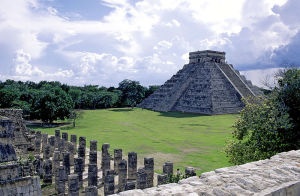Susan and I have spent some time on the Yucatan Peninsula in Mexico, and the Maya ruins around there are wonderful places to haunt. If you visit the ruin called Chichen Itza and hire a local guide, he will usually demonstrate an interesting accoustical phenomenon of the central pyramid called Kukulkan. If you stand in front of one of the four staircases ascending this pyramid and clap your hands sharply, the echo that returns from the steps is not your handclap, but a short, descending chirp. It’s very weird. (Go here to hear it on Youtube.) We were all standing around my little brother Byron’s hospital bed recently (he was finally getting his cervical spine patched up after years of having way too much fun) trying to explain this to ourselves. Byron is a musician, and I’m a recovering musician, and we’ve both had to set up sound systems and make them work in God knows what kinds of rooms, so we both fancy ourselves to know a few things about accoustics. But try though we did for a couple of hours, we were unable to make up a convincing theory. I finally broke down and did some actual reading.
So: If I understand this right, here’s what happens according to the Acoustical Society of America:
Each step riser (the riser is the vertical face of a step, for those of you who have never built a staircase) sends one shock wave from your clap back to you, and is perceived as a single sound wave, a single cycle—that is, exactly one impact on your eardrum. Combined over the number of steps (91), it becomes a brief tone 91 cycles long, which ends after the furthest step has sent back its echo. And the tone would be all on that one pitch and not drop—that is, not chirp—except for one interesting geometric effect: The steps farther from you are also higher above you, so your line of hearing becomes slanted as they go up, which means that the steps farther up, when measured along that increasingly diagonal line, are farther apart from one another than the ones directly in front of you. So the frequency of the sound slows down, which we perceive as a drop in pitch. The result is a brief, descending chirp.
The chirp is suspiciously similar to the chirp of the resplendent quetzal (pictured), a sacred bird to the Maya (now endangered), and there is fun argument in the archaeological community about whether this was intentionally done by the Maya, and whether they could have had the acoustical engineering chops to pull it off (nothing would surprise me about the Maya). In fact, there is now an emerging field in archaeology called accoustic archaeology. Accousic archaeology is now being taken fairly seriously, but in the late sixties the claims were pretty out there. Some were claiming that the singing voice of a mason could be recorded in the mortar as his trowel vibrated to his voice while he worked it. Pretty fru-fru stuff, and it actually got debunked by none other than my favorite TV show, Mythbusters. But now, in no small part because of this Chichen Itza thing, acoustic archaeology is being pursued more seriously, and taken more seriously, and according to the acoustic archaeologists, if the Maya did imitate the call of the quetzal intentionally in the building of this pyramid, it constitutes the first recording of a sound.
Another of the loved ones around Byron’s bed mentioned that it is odd that the stair risers on Maya pyramids are so high (10.3 inches in this case) while the Maya were a fairly short people. (Susan and I can vouch for that–we’ve climbed several of those pyramids and our knees always pay.) The quetzal theory offers a good explanation for that, since shorter risers would be far less effective at producing this chirp, and would not immitate the call of the quetzal as well.
Now you know.



I so dream of being to this place one day, hope it happens soon to me. I am so astonished by the fact that a claps echo is chirping sound!!!!